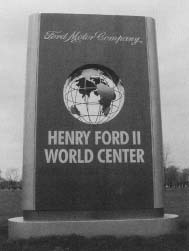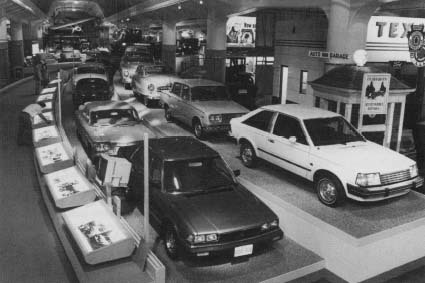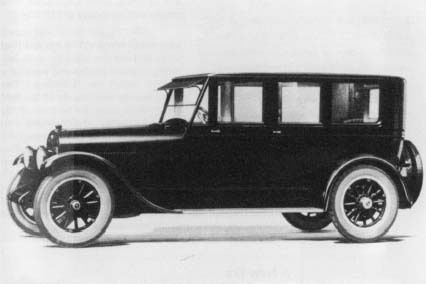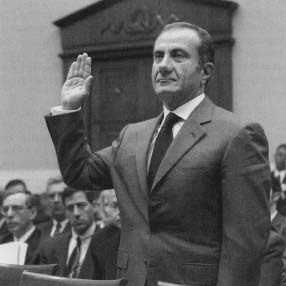Ford Motor Company
1 American Road
Dearborn, Ml 48126
(313) 845-8540
www.ford.com

Thinking of the Ford Motor Company conjures up many images—durable trucks that are "built Ford tough"; fancy coupes like the Thunderbird; fast cars, such as the Mustang; and sport utility vehicles (SUVs) like Explorers. Ford cars are part of American culture, and have been since company founder, Henry Ford, designed and built his first Model T in 1908. In the twenty-first century, Ford Motor continues to expand its empire, which includes not only Ford, but Lincoln, Mercury, Aston Martin, Jaguar, Land Rover, Mazda, and Volvo.
The Birth of the Automobile
In the last decades of the nineteenth century, the world was rapidly changing. Many modern conveniences were invented, including the typewriter and telephone, electric lights, and the first automobiles. Inventors had been experimenting with steam-powered vehicles since the late 1700s, but these early cars were noisy, hard to operate, and sometimes dangerous since they had the potential to explode. In 1885, German engineer Karl Benz (1844-1929) is credited with building the first automobile of modern design.
Benz's three-wheeled vehicle was very primitive and could only travel about eight miles per hour. Every passing year, however, inventors and engineers from all over the world continued to make advancements. In Germany, Gottlieb Daimler (1834-1900) and William Maybach (1846-1929) together were inspired to build motor-powered vehicles to replace the slow, bumpy rides of horse-drawn carriages. And, in the United States, Henry Ford built his first car, called the "Quadricycle," in 1896.
While Ford, Benz, Daimler, and a host of others were building these early automobiles, the buying public was not terribly interested. Ford entered several of his early cars in races just to gain attention for his increasingly sophisticated vehicles. The strategy worked and over the next few years he was involved in the start-up of three new companies. The first was the Detroit Automobile Company, a partnership Ford formed in 1899 with the city's mayor and a local lumber baron. It was the first official auto manufacturer in Detroit, Michigan. The company lasted only a year, but was reorganized in 1901 as the Henry Ford Company.
Ford Motor at a Glance
- Employees: 350,000
- CEO: William Clay Ford Jr.
- Subsidiaries: Ford Motor Credit Company; Mazda Motor Corporation; Premier Automotive Group (Aston Martin, Jaguar, Lincoln, Land Rover, Volvo); QualityCare Service; Kwik-Fit; Hertz
- Major Competitors: General Motors Corporation; DaimlerChrysler AG; Toyota Motor Corporation
- Notable Products: F-Series trucks; Mustang; Thunderbird; Explorer; Lincoln Towncar and Navigator; Land Rover Discover, Freelander, and Range Rover; Mazda Miata and MPV; Jaguar X-and S-Series cars; Volvo S-and V-Series cars, Aston Martin Vantage and Vanquish
Ford and his investors disagreed about the kinds of cars their company should build. In 1902, Ford resigned to design and build his own race cars, including the "Arrow" and the "999." The "999" won a local competition and set a new record by racing five miles in five minutes and twenty-eight seconds. This exposure led to financial backing, and soon Ford and Alexander Malcomson, a local coal merchant, formed the Ford Motor Company on June 16, 1903. It was the very same year that brothers Orville (1871-1948) and Wilbur Wright
Timeline
- 1903:
- Ford Motor Company is founded.
- 1906:
- Henry Ford takes over presidency of the company.
- 1908:
- Model T is introduced.
- 191 3:
- The assembly line is introduced.
- 1919:
- Henry's son, Edsel, takes over as president.
- 1922:
- Ford acquires Lincoln Motor Company.
- 1925:
- Company builds first airplane, the 199 Ford TriMotor.
- 1927:
- Last Model T is produced.
- 1932:
- First V-8 (eight-cylinder) engine is produced.
- 1939:
- Edsel's Lincoln Continental causes a sensation.
- 1943:
- Edsel dies and Henry retakes the presidency.
- 1945:
- Henry steps down again; grandson Henry II replaces him.
- 1947:
- Henry Ford dies at age eighty-three.
- 1948:
- First F-Series pickup trucks produced.
- 1955:
- Ford Thunderbird sports car introduced.
- 1964:
- Ford Mustang launched at World's Fair.
- 1968:
- Jacques Nasser joins company.
- 1979:
- Company buys stake in Toyo Kogyo (later Mazda).
- 1980:
- Henry Ford II resigns as chairman.
- 1985:
- Ford Taurus introduced.
- 1986:
- Company buys stake in Kia Motors of Korea.
- 1989:
- Buys British luxury carmaker jaguar.
- 1999:
- William "Bill" Clay Ford Jr., great-grandson of Henry Ford, becomes chairman.
- 2001:
- Bill Ford becomes CEO and president after Nasser leaves.
- 2003:
- Ford celebrates its one-hundredth anniversary.
(1867-1912) flew their first airplane at Kitty Hawk, North Carolina.
A New Era of Car Making
Ford Motor was a company with a simple goal: to produce and sell well-built cars at a competitive price. Using an old wagon shop on Mack Avenue in Detroit, Michigan, Ford designed the company's first vehicle called the "Model A." He sold his first car about a month later to a local doctor. As chief engineer, Ford improved on his design and developed new cars. He named the cars by following the alphabet. For example, the Model A was followed by Models B, C, E, and F. By 1904, the Ford Motor Company had done so well that the partners were able to finance their first manufacturing plant outside the United States in Ontario, Canada. The company also moved from the converted wagon shop to larger quarters at the intersection of Piquette Avenue and Beaubien Street in Detroit.
With success, however, also came failure. Although the Model A and its successors had been quite popular, the new Model K brought out in 1906 was not. This caused trouble between Ford and his business partners, who quarreled with the direction Henry seemed to be taking the company. Ford insisted that the company make less expensive vehicles so average people could afford to own a car. The result was a major shift in management, with Ford taking over as president and buying out many of his original investors and their shares of the business.
In 1906, the Model N was introduced. It was a four-cylinder car that sold for just $700, as opposed to the alarming price tag of the Model K, which was $2,800. The Model N brought Ford into a new era, with profits reaching $1 million for the first time. Having outgrown its plant in Detroit, the company began construction on a huge new facility in Highland Park, north of the Detroit city limits. As builders broke ground on the new plant, Ford used the Model N as a base for his next new automobile—which was destined to change the Ford Motor Company forever.
The Model T was introduced in 1908 as Henry Ford's idea of a "universal" car—a stylish, sturdy automobile that was affordable to all Americans who wanted to drive. Solid, dependable,

Celebrating Success
The reason why Ford could sell his cars cheaper was that he had developed a way to make cars faster. In 1913, he introduced the assembly line method of production, which revolutionized the automotive industry. In an assembly line, the framework of a car rests on a moving surface called a conveyor belt. The belt passes by different workers, each of whom is responsible for a single task. With the assembly line, the time required to build a new car was reduced from over twelve hours to an hour and a half. This means that a manufacturer could produce many cars in a single day instead of just one or two. Because he could "mass produce," Ford was soon selling about half of all the cars sold in the United States. At the same time, more assembly plants were built to keep up with consumer demands and dealerships popped up across the country to sell Ford cars.
Ford not only streamlined the work in his companies, he also paid his employees well. In 1914, hoping to build loyalty and worker pride, he doubled wages to $5 per day. The work day was also cut to eight hours. This change made Ford a famous man; his face and business policies were soon written about in countless newspapers and magazines. With the assembly line method in full use by thousands of well-paid workers, Ford production soared over the next few years, reaching nearly half a million cars in 1916.
During this time Ford also began designing farm equipment, beginning with tractors and small trucks. Yet as World War I (1914-18) raged in Europe, it became apparent America would soon join the war effort. When the United States officially declared war on Germany in April 1917, Ford turned the use of his factories over to the government and the company began building trucks, ambulances, small tanks, airplane motors, and even helmets.
A Son Takes the Helm
After the war ended in November 1918, Henry Ford announced his retirement. In 1919, his son Edsel (1893-1943) took over the company. That same year, Ford Motor broke ground for an immense plant on the Rouge River in Dearborn, Michigan. In 1922, Ford purchased rival automaker Lincoln Motor Company, which had introduced the first V-8, or eight-cyclinder, engine the year before.
The first automobiles were very expensive to manufacture and only the very rich could afford to buy them. In 1900, an average worker earned less than $500 a year. When the Model T was introduced, it sold for around $900, which was almost twice as much as an individual's yearly salary. By the 1920s, the price of a Model T was less than $300, which made it affordable for the average middle class worker.
Ford Motor also shifted into the aircraft industry. Convinced that airplanes were the transportation of the future, Edsel

In 1927, after nineteen years of production, Ford decided to discontinue the Model T. Although it had been extremely popular, the Model T was facing stiff competition, most notably from Chevrolet, which had come out with faster, more luxurious cars. After the last Model T rolled off the assembly line in May, Ford closed down its plants while engineers went to work on a new vehicle. After several months of sitting idle, the factories began work on the Model A, an updated version of the original. The new and improved car had a more powerful engine, more space, and a "safety glass" windshield that resisted shattering.
The new Model A was introduced in December 1927 and was a favorite with buyers until the Great Depression hit in 1929. Although the Depression financially devastated much of the United States and its citizens, Ford survived. The company did, however, suffer losses since most people had no money to buy cars.
The United States was drawn into World War II (1939-45) and Ford supported the war effort by manufacturing airplane motors and parts for a bomber called the "Liberator." Two years into the war, tragedy hit the Ford family when Edsel died of cancer at the age of forty-nine. Henry, whose own health had been declining, came back to run the company as president, then turned the reins over to grandson
Henry II (1917-1987) in 1945. In 1947, Henry died and his legacy was carried on by Henry II, whose guidance helped turn the family company into a huge international corporation. Two other Ford grandsons, Benson and William Clay, also joined the business and lent a hand.
A New Era
Over the next years, Ford had its ups and downs: the rugged F-Series trucks were launched in 1948 to much acclaim; a fancy two-seater called the Thunderbird excited the industry with its power and luxury in 1955; the Edsel sedan flopped in 1958; and the speedy Mustang, introduced in 1964, was an extremely hot seller, especially with young people. Ford then entered the mostly ignored off-road category of vehicles with four-wheel or all-wheel drive. To compete with Jeep and Land Rover, which had been in business since the 1940s, Ford introduced the Bronco in 1965.
At the end of the 1960s a young man named Jacques Nasser joined Ford's training program while a college student in Australia. During the 1970s, Nasser moved around the world, working at various Ford divisions and earning a reputation as a sharp businessman with leadership qualities. As Ford opened new assembly plants and expanded operations in Asia and Europe, Nasser steadily climbed the corporate ladder.
Legend has it that while vacationing in Florida in 1939, Edsel Ford was seen driving a flashy new car called a Lincoln Continental. He caused quite a commotion, and hundreds of hopeful buyers called Ford Motor Company to ask about the car. The Lincoln Continental was soon a major hit in the automotive industry.
In 1979, Ford bought part of the Japanese firm Toyo Kogyo, which later became known as Mazda. The next year, 1980, Henry II stepped down as president. In 1985, in order to

In the 1990s, Ford started to produce minivans and SUVs, and by 1992 the Ford Explorer ruled the sport utility market. Ford bought into the rental car industry in 1992, acquiring Hertz and then rival Budget in 1996, supplying these firms with thousands of Ford-made cars, trucks, and sport utility vehicles. Budget was sold in 1997, but Ford held on to Hertz, the nation's number-one rental car company.
Hit by Scandal
In 1999, William "Bill" Clay Ford Jr., great-grandson of founder Henry, was named chairman and Jacques Nasser became chief executive officer (CEO) and president. That same year, Ford faced perhaps the biggest crisis in the company's history. Ford Explorers, the country's top SUV, were involved in rollover accidents injuring and sometimes killing occupants. After intense investigation, the problems were attributed to the Firestone Wilderness AT tires, which were installed on all Explorers at Ford factories. Forced to recall and replace thirteen million tires, both Ford and Bridgestone/Firestone were faced with scores of lawsuits and lost billions.
The Explorer and Firestone tire crisis, as well as other problems, brought an end to Jacques Nasser's long career at Ford. He left the company in late 2001 and Bill Ford assumed his responsibilities as CEO. Bill Ford was determined to get back to business as usual, yet this required several immediate measures, including the discontinuation of the Lincoln Continental, the Mercury Cougar and Villager, and the Ford Escort compact car. The model cutbacks were just the beginning of a major rehaul for the company, which included layoffs and the closing of three assembly plants in the United States and Canada.
Gearing Up for the Future
As Ford Motor prepared to hit its one-hundredth anniversary in 2003, the company was ranked as the world's largest truck manufacturer and the second-largest producer of cars with operations in thirty countries around the globe. With annual sales of more than $160 billion, today's Ford Motor Company is a giant of the automotive industry. After one hundred years, Ford has changed a great deal but remains in the family—founded by Henry Ford in 1903 and run by Bill Ford in 2003.
However, I am puzzled as to why the chronological timeline at the
top of the page omits any reference of the Model A---1928-1931.
I will probably have to go out to my garage and console my 1929
sport coupe! LOL Seriously, is there a reason?
Thanks,
Jack Smith